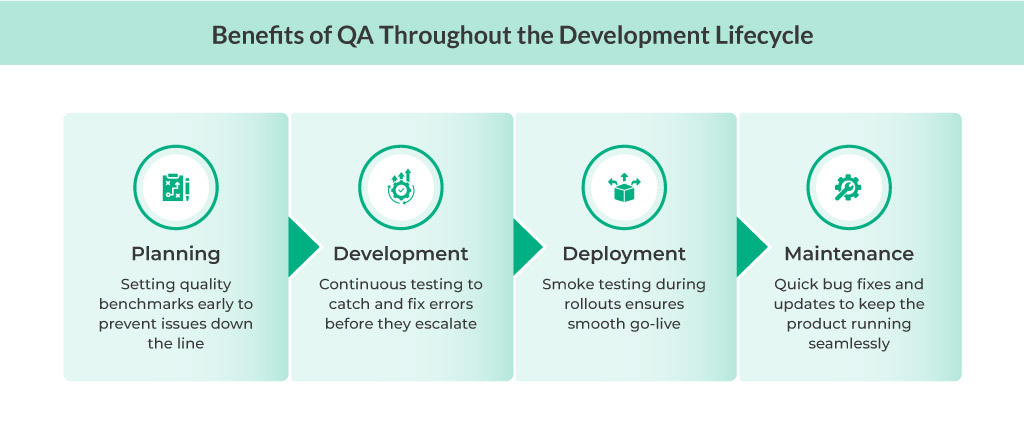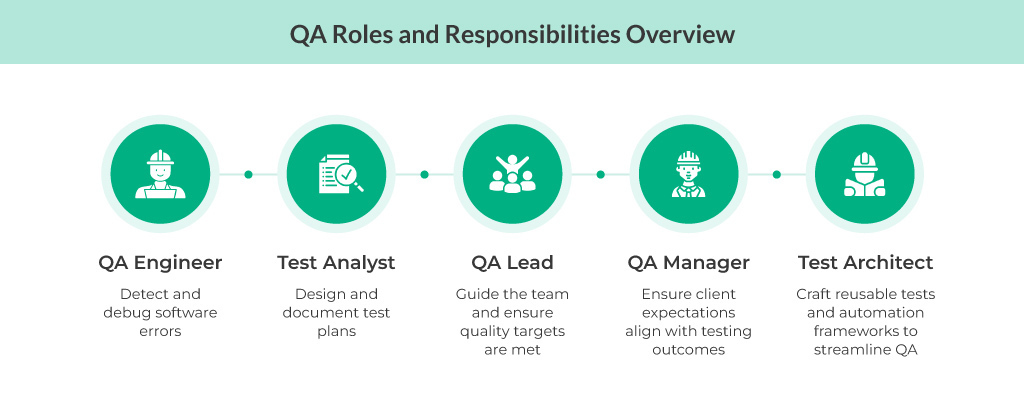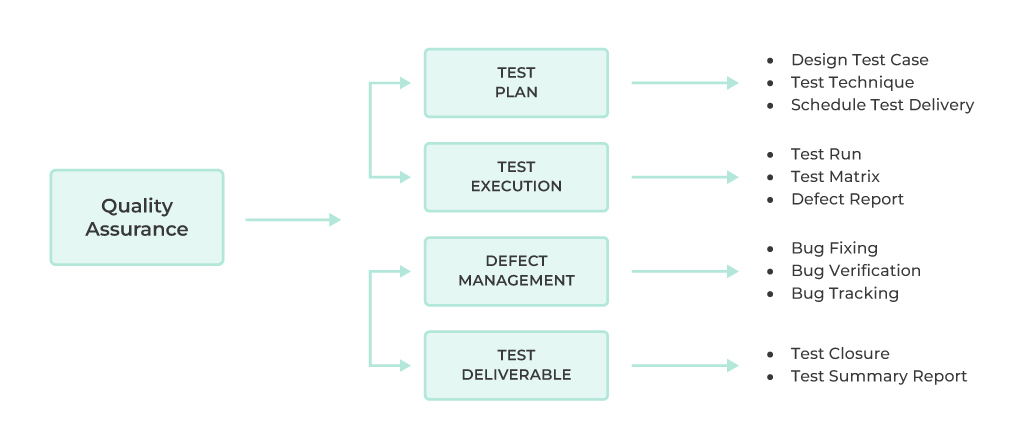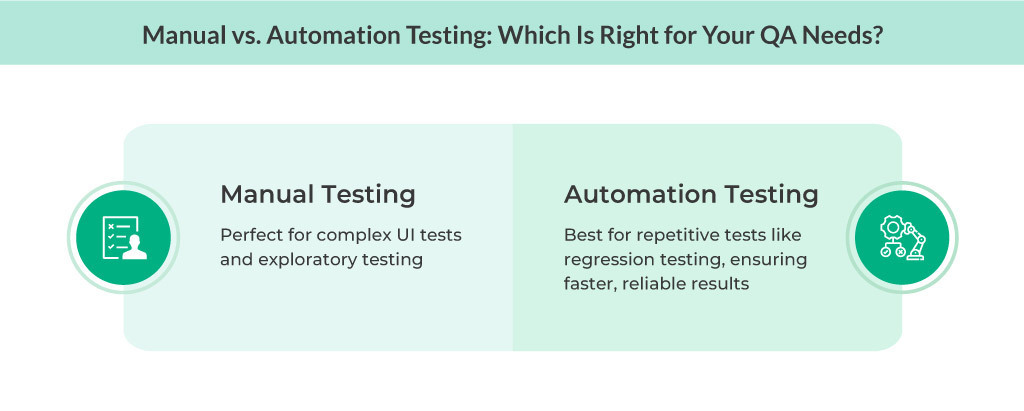Software quality is always a challenge, and it becomes difficult when the QA roles and responsibilities are not satisfied. You should understand the role QA plays throughout the development lifecycle whether you manage software development or run a software business.
Quality assurance is the process of evaluating a system by applying proper testing procedures to provide confidence to achieve an appropriate level of quality. Quality Assurance helps the software development team to recognize the problems early by performing rigorous testing, to guarantee a high-quality product to the end user.

So Who performs this role?? With no startle “Quality Analyst ” is the one…
The software quality analyst is an individual who is responsible for applying the principles and best practices of software quality assurance throughout the software development life cycle.
QA is an essential part of the Software development process, as they test and assess the quality of the software to reduce the risk of software failure in operation.
As John Ruskin says, “Quality is never an accident; it is always the result of intelligent effort”
What are QA roles?

Quality assurance (QA) roles are responsible for creating and performing tests, identifying errors, and providing feedback to verify that a final product meets a company’s quality requirements. This profession has become more common in the technology sector depending on the kind of work a company does, it frequently calls for various levels of extensive experience or specialization. Video games, websites, and applications are examples of common development projects that call for QA roles.
Because they ensure users enjoy a seamless, error-free experience while using a product, QA jobs are crucial. A company that hires these people can consistently create high-quality products. It helps to maintain the brand reputation and customer satisfaction.
The QA analyzes and executes the products in all possible logical ways for a quality product, As the Software testers do not make software; they make them better. So a QA performs software testing where they evaluate the functionality of a software application to find whether the developed software is error-free.
But testing is not the only part of QA, it analyses whether the software follows all business requirements, and functionality offering an easy and secure user interface that facilitates effortless workflows for the end-users.
The Role of Quality Assurance (QA) in Deployment
During a deployment, QA typically needs to be on call. These occur frequently late at night (most probably) when users are less likely to be affected. QA is on standby during a deployment. As soon as the release goes live, QA gets to work, undergoing smoke testing to ensure that the deployment went smoothly.
The Role of Quality Assurance (QA ) in Maintenance
Bugs do occasionally slip through, even the best automation or manual testing cannot find all the bugs on browser plugins all of the time. QA can be on hand to test the feature updates or bug fixes.
Different Roles and Responsibility In The Quality Assurance Team
The following is a list of important QA positions to hire if you want to develop a functional software testing team, along with the various responsibilities and abilities each role typically handles:
QA Engineer
Quality assurance engineers examine programs to identify bugs and defects, especially when they appear unexpectedly. To evaluate the effectiveness of various product functionalities and aspects, they frequently use a variety of tests. Senior QA engineers perform some tests through automation testing whereas others are through manual testing.
Test Analyst
Test analysts support the test engineer by developing test plans and reviewing the most crucial features and functionalities to test. Usually, they document the testing process. To support the entire QA team, they record the goals, progress, and outcomes of tests.
QA Lead
The QA lead is a team leader who is in charge of overseeing the testing process. They plan to make sure testing is efficient and completed on schedule. Additionally, QA team leads may define the single project specifications, supervise engineers and quality assurance analysts, and takes part in the recruitment and training of QA professionals.
QA Manager
QA test managers manage the communication between the customers and the QA team. In addition to working with the customer to produce standards and specifications, they would deliver reports and updates. They might also collaborate with analysts or account managers to evaluate product quality and ensure it lives up to customer expectations.
Test Architect
The tests used by the QA team are designed and built by test architects. Typically, their goals are to create tests that the team may reuse on future projects and to create automation frameworks that define the best quality assurance process for automated tests. Test architects can also need analysis to ensure that the tests they create address organizational priorities and concerns.
Roles And Responsibilities Of QA :
The role of quality assurance (QA) in testing may appear obvious. But during the testing phase, QA performs more than just testing. A tester’s time is mostly spent on specific tasks, such as writing test cases and bug reports. Of course, QA will (or should) test the app or website thoroughly. But other activities consist of:
• Test planning – Which involves activities of defining the objectives of testing and the approach for meeting test objectives.
• Test Strategy – Create a test strategy based on project requirements and schedules.
• Early testing to eliminate defects at an early stage reduces the bug fixing cost and time.
• Executing tests with appropriate techniques (manually or by using test execution tools) and documenting testing failures.
• Analyze the Defects and identify the root cause.
• Troubleshoot defects, such that it does not affect the product quality.
• Report defects to software developers by recording software defects with a bug-tracking system. (e.g Bugzilla, mantis, QA Touch, etc.)
• Inform the test progress against a schedule of the quality management.
• Interact with BA, project manager, development team, and client as per need.
• Conduct different test procedures, report issues, and follow up on the status of the issues.
• Collaborate with the software testing team to assess or diagnose problems and suggest possible solutions.
• Monitor and analyze the performance using tools for efficient and problem-free operations.
• Uncover vulnerabilities in the system and determine that its data and resources are protected from intruders.
• Provides a test summary report that reflects the software under the test’s top-notch quality.
• Manage the entire testing activity with different test management tools. (eg. QA Touch)
 How Do You Organize a QA Team Work to Be Effective?
How Do You Organize a QA Team Work to Be Effective?
The roles and responsibilities mentioned above are not necessarily present in every team. Some important roles merge, and the responsibilities of specialists change.
Automation testers are not always available on in-house teams. The job of a QA analyst can be performed entirely or in part by a manual tester. A QA architect is more in demand in large organizations with intricate systems.

The level of cooperation among your team members will determine the best management style. You can work with a remote QA company or hire an in-house QA company.
Conclusion
QA tests the proficiency of the product in all aspects by evaluating them using software testing techniques. QA is an essential factor for software development as they help to provide a quality and reliable product to the end user.
Quality assurance is one of the most undervalued and potentially important tasks in the software development process. Despite the widespread software failures, you can look at the little progress in elevating the relevance of the quality assurance role.
The financial limitation forces businesses of all sizes to release software beta versions that encourage users to spot the product’s defect on their own. For the software development industry, it is necessary to elevate the role of quality assurance to gain the professional respect it requires.
The demand for faster delivery to the market made “Quality” and “team accountability”. This drives testers to do something beyond the planning and execution of the tests, which leads to the future of QA with predominant factors such as Agile, Artificial Intelligence (AI), and Codeless automation testing.
FAQs
What does an engineer in quality assurance do?
Before a product launch, a QA test engineer can create tests that reveal software issues. These tests involve important tasks like developing and executing new tests and reporting the test results to stakeholders so they can collaborate to resolve any defects or bugs with the program.
What are a software quality assurance engineer’s roles and duties?
Preventing defects is the primary role of the QA Engineer. They are also in charge of identifying and eliminating any errors in the code before releasing it to the customer. Such errors can cause serious issues, including insufficient data input or an incorrectly designed interface element.
What defines an effective software quality assurance engineer?
A sound QA engineer is well-organized, has good communication skills, capable of changing priorities, and technical skills, and is extremely meticulous. They are adaptable enough to adapt to variations in different software products or quality assurance processes while managing to create a compromise between the ideal and a good-enough result.










